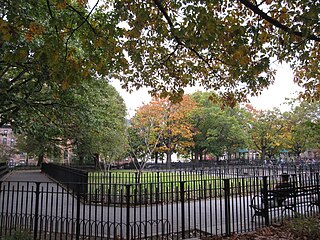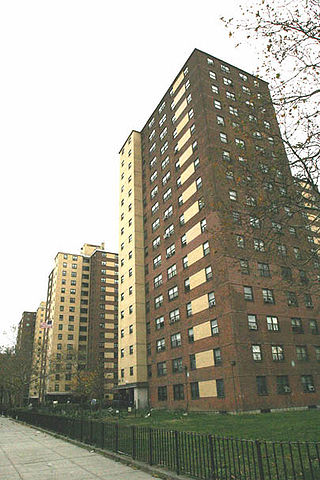
Clinton Hill is a neighborhood in north-central Brooklyn, a borough of New York City. It is bordered by the Brooklyn Navy Yard and Flushing Avenue to the north, Williamsburg to the northeast, Nostrand Avenue and Bedford–Stuyvesant to the east, St Marks Avenue and Prospect Heights to the south and southwest and Carlton Avenue and Fort Greene to the west.

Cobble Hill is a neighborhood in the northwestern portion of the New York City borough of Brooklyn. A small neighborhood comprising 40 blocks, Cobble Hill sits adjacent to Brooklyn Heights to the north, Boerum Hill to the east, Carroll Gardens to the south, and the Columbia Street Waterfront District to the west. It is bounded by Atlantic Avenue (north), Court Street (east), Degraw Street (south) and the Brooklyn Queens Expressway (west). Other sources add to the neighborhood a rectangle bounded by Wyckoff Street on the north, Hoyt Street on the east, Degraw Street on the south, and Court Street on the west.

Fort Greene is a neighborhood in the northwestern part of the New York City borough of Brooklyn. The neighborhood is bounded by Flushing Avenue and the Brooklyn Navy Yard to the north, Flatbush Avenue Extension and Downtown Brooklyn to the west, Atlantic Avenue and Prospect Heights to the south, and Vanderbilt Avenue and Clinton Hill to the east. The Fort Greene Historic District is listed on the New York State Registry and on the National Register of Historic Places, and is a New York City designated historic district.

Prospect Heights is a neighborhood in the northwest of the New York City borough of Brooklyn. The traditional boundaries are Flatbush Avenue to the west, Atlantic Avenue to the north, Eastern Parkway – beginning at Grand Army Plaza – to the south, and Washington Avenue to the east. In the northern section of Prospect Heights are the Vanderbilt Rail Yards, built over as part of the Pacific Park project. The Barclays Center, home to the NBA's Brooklyn Nets basketball team, is located in the northwestern corner of the neighborhood in Pacific Park at Flatbush and Atlantic Avenues.

Brownsville is a residential neighborhood in eastern Brooklyn in New York City. The neighborhood is generally bordered by Crown Heights to the northwest; Bedford–Stuyvesant and Cypress Hills to the north; East New York to the east; Canarsie to the south; and East Flatbush to the west.

Bedford–Stuyvesant, colloquially known as Bed–Stuy, is a neighborhood in the northern section of the New York City borough of Brooklyn. Bedford–Stuyvesant is bordered by Flushing Avenue to the north, Classon Avenue to the west, Broadway to the east, and Atlantic Avenue to the south. The main shopping street, Fulton Street, runs east–west the length of the neighborhood and intersects high-traffic north–south streets including Bedford Avenue, Nostrand Avenue, and Stuyvesant Avenue. Bedford–Stuyvesant contains four smaller neighborhoods: Bedford, Stuyvesant Heights, Ocean Hill, and Weeksville. Part of Clinton Hill was once considered part of Bedford–Stuyvesant.

Brownstone is a brown Triassic–Jurassic sandstone that was historically a popular building material. The term is also used in the United States and Canada to refer to a townhouse clad in this or any other aesthetically similar material.

Ocean Hill is a subsection of Bedford–Stuyvesant in the New York City borough of Brooklyn. The neighborhood is part of Brooklyn Community Board 16 and was founded in 1890. The ZIP code for the neighborhood is 11233. Ocean Hill's boundaries start from Broadway and the neighborhood of Bushwick in the north, Ralph Avenue and the neighborhoods of Bedford-Stuyvesant proper and Crown Heights to the west, East New York Avenue and the neighborhood of Brownsville to the south, and Van Sinderen Avenue and the neighborhood of East New York to the east.

Mary of Nazareth Parish was formed in 2008 with the merger of Sacred Heart Parish and the Parish of St. Michael and St. Edward.

Queens Hospital Center (QHC), also known as NYC Health + Hospitals/Queens and originally called Queens General Hospital, is a large public hospital campus in the Jamaica Hills and Hillcrest neighborhoods of Queens in New York City. It is operated by NYC Health + Hospitals, a public benefit corporation of the city.
The Brooklyn Jewish Hospital and Medical Center was an academic, sectarian hospital in Crown Heights and Prospect Heights in Central Brooklyn. It merged with St. John's Episcopal Hospital to form Interfaith Medical Center in 1983.
Josephine English (1920-2011) was an American gynecologist who was the first black woman to open a private practice in New York. She was also known for her work in real estate and health care, in addition to her philanthropy towards the arts. Her practice was jeopardized in 1995 due to financial issues with the Adelphi Medical Center. Many of her establishments have risked foreclosure, and lacked repair funds.

New York Community Hospital is a hospital in Brooklyn, NY that was founded in 1929 by two brothers, both doctors. The hospital has been renamed several times before becoming part of New York-Presbyterian Hospital in 1997. They more recently partnered with Maimonides Medical Center. The hospital, which was described as "One Address, Many Hospitals" due to changing names, offers Kosher meals to patients.

Linden General Hospital was "a 78-bed private health facility in a rundown part of Brooklyn's East New York section." It was a "two-story brick" building located at 501 New Lots Avenue.
Midwood Hospital opened in 1907 as Midwood Sanitarium. It closed in the 1970s, and its building served as a private school from 1979 thru 2000.
Cumberland Hospital was a 366-bed municipal hospital located in Fort Greene, Brooklyn.














